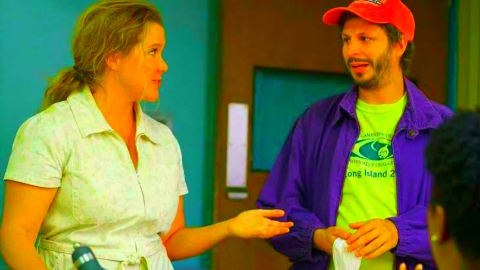He’s right Antonio Solinas when, in the introduction a The Goddamned: The Virgin Brides, specifies how the nature of the religious story par excellence, the Bible, is the subject of various interpretations, not least the opinions that see it as an allegorical fantasy tale. Without going into a complex religious discussion, the allegorical intent of some parables or events presented in this sacred text cannot be denied, thanks to the presence of human and divine figures who have within themselves the typical elements of the subsequent fantastic narrative. An influence not only stylistic but also humoralwhich has stimulated the curiosity and inventiveness of dozens of authors, not least Jason Aaron.
Name known in the comics world for large cycles such as Southern Bastards or runs of beloved characters from the two giants of superhero comics, such as Strange or Wolverine. Within his work with the majors, Aaron had to move within parameters dictated by continuity of the characters, but to animate the authentic narrative of the screenwriter, unrestrained, is his personal experience, that of a young man raised in Alabama, one of the states of the States known for its fervent attachment to religion. A society still rooted in certain religious tensions that are combined with a traditional, not to say retrograde mentality, in which the influence of religious precepts dictates a rather narrow world view. On Aaron, who grew up in this environment, the religious element therefore exerted a strong pressure, forcefully entering his production as a ‘free’ author, as demonstrated The Goddamned: The Virgin Brides.
The Goddamned: The Virgin Brides, faith or free will?
Second chapter of a cycle that began with The Goddamnedin which Aaron tackled another theme dear to the biblical story, that is, punishment and redemption, giving life to a violent world populated by mythological monsters in which the immortal Cain is forced to exhale his guilt with eternal life. A sort of ruthless retaliation, which punishes the first fratricide with immortality, forcing him to live as a pariah in an increasingly ruthless world. The first chapter of this cycle was based on a reinterpretation of the biblical myth of the first murderbut having completed this rewriting, useful to welcome the reader into this world where fantasy and the sacred are intertwined, it was time to address other questions raised by the stories of the Bible.

The Goddamned: The Virgin Brides goes towards the most discussed question of faith: do we have to blind obedience? Is the renunciation of free will inescapable? This is what the young women entrusted to the care of the Old Mothers are led to believe, venerable elderly people who grow up adolescents in their idyllic valley at the foot of the sacred mountain, preparing them to become Brides. With the arrival of the menarche, these young women become women ready to join in marriage with the Nephilim, the angelic children of God, giving life to their offspring. Watching over this sacred mission are the Holy Mountain Warriors, women dedicated to war, charged with capturing new girls to keep this tradition alive.
This is the life that also awaits Jael and Shurri, two little girls destined to become brides. Rebellious and unwilling to accept her own destiny, the second more meek and aligned to the doctrine, the two friends find themselves having to accept their destiny when Shurri becomes a woman, thus preparing to become a Bride. A moment that pushes the two friends to leave the safety of the valley to seek salvation elsewhere, after they discover the horrendous truth behind the rituals with which they were raised, trying to save a friend who has become a bride.
If the first volume of Aaron’s cycle seemed to limit itself to rewriting the myth of Cain, at the same time seeking a humanization of the fratricide, arousing a vein of empathy in the reader, with The Goddamned: The Virgin Brides the feeling is that Aaron has aimed to create an even more marked break with the religious element of his upbringing. There are no half measures, no allegories and metaphors are sought, the author’s critical intent has an indomitable vivacity, which is not so much nestled in the scenes of bloody violence as in the dialogues. The choice to make two adolescents, on the threshold of puberty, our point of view of this story is biting, entrusting to their voice some violent reflections in terms, bordering on blasphemy if we will, but which hide in their vehemence a suffering, human sensitivity.

Even if inserted within a dynamic from dark grim, the story narrated in The Goddamned: The Virgin Brides does not fail to offer an acid vision of the biblical allegorical tale, in which the elements usually associated with the embodiment of vices and virtues are brought closer to the categorization of fantasy fiction. The tempting serpent therefore takes on draconic features, also becoming the embodiment of the struggle between free will, understood as opposition to a divine imposition of one’s destiny, and blind obedience to belief. Faith or identity, we could say, considered as Jael and Shurri’s personal story is based on this emotional contrast.
Rewriting the biblical myth by declining it in a fantastic key
Aaron interprets this dichotomy with particular vehemence, giving, as mentioned, great importance to the dialogue between the characters as an element of stinging analysis. If on the one hand the faithful servants of the cult do not fail to alternate great ritual declamations with a more daily talk full of vulgarity, the words of the two fugitives are those that offer the most ruthless and blasphemous comments, made organic in the narration of The Goddamned: The Virgin Brides because they create an emotional connection between image and story, which culminates with a final examination of the role of the bearer of truth who clashes with the enslaved submission to dogmatic creed. A modern and secular rewriting of the Luciferian role, which is told with extreme clarity and crudeness.
In fact, the perfect visual interpretation of rm Guéraalias Rajko Milosevic, already author of the drawings of the first volume. Where is it The Goddamnedespecially in the first part, was based on the construction of a barren and violent world, The Goddamned: The Virgin Brides seeks a richer visual representation, where thehe luxuriant valley where virgins grow is portrayed as an Eden, a representation that sharpens that sense of dissonance between the words of the creed and the reality experienced by the young protagonists. Guéra also creates a profound characterization of the different elements that make up this society, such as white dresses for the Brides, which contrast with the hidden caverns in which the deformed creatures born from these wicked marriages live.

The stylistic figure of the Serbian but damage author residing in Spain is affected by the influence of the Iberian school, especially in the management of the movements of the characters and in the expressiveness of the faces, where the eyes always have a perceptible pre-eminence. A definition that passes from the violent dashes of Jael’s rage to the more composed inner strength of Shurri’s delicate posesin a visual balance that is further enhanced by the color palette of Giulia Buscowho thanks to his academic preparation in terms of coloring, manages to present a chromatic identity for The Goddamned: The Virgin Brides never banal, capable of giving life to suggestive plays of shadows even within moments characterized by strong luminosity.
Panini publishes The Goddamned: The Virgin Brides within its 100% HD series, a repository of mature and often controversial stories. The volume reflects the typical style of these publications, a hardcover characterized by traditional graphics, which inside offers a small gallery of covers.


